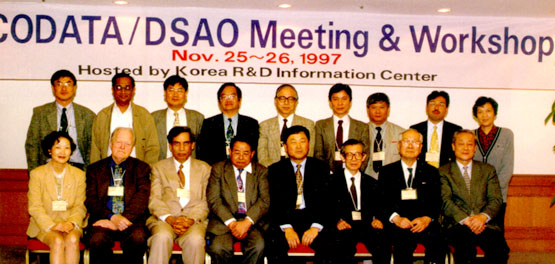
CODATA Task Group on Survey of Data Sources in Asia-Oceanic Meeting in Taejon, Korea
|
Committee on Data for Science and Technology CODATA Newsletter Number 78 July 1998 |
Images to follow shortly
International CODATA Conference, New Delhi, India, November 1998
ICSU-CODATA (Committee on Data for Science and Technology) will hold its 16th International Conference and General Assembly at New Delhi, India in November 1998. These conferences provide a forum for interaction and information transfer between multi-disciplinary, leading scientists and engineers engaged in data generation, evaluation, dissemination, and applications. The fast changing scenario in information generation and management technology, particularly in networking at national and global levels, necessitates frequent reviews of the state of the art and discussion on trends and important aspects of the field. This modern technology has a vital role to play in sustainable development of society.
Bearing the title "Scientific and Technical Data and Communication for the Sustainable Development of Nations" and the slogan "Data Management in the Evolving Information Society," this 16th International CODATA Conference will be hosted by the Indian National Organizing and the Local Organizing Committees.
Leading scientists will make presentations reviewing the state of the art and their vision for the future, and active resarchers will have opportunities to share their research results. The scientific program has been arranged to feature some 49 lectures (13 Indian, 8 other Asian, 2 Russian, 10 North American, and four others), over the four days of the Conference. Though the number is smaller, it consequently offers a trade off, by elimination of parallel sessions, compared to previous CODATA Biennial International Conferences. However some 43 contributed papers have been accepted as posters in three poster sessions.
Short oral sessions by selected young scientists, poster sessions for contributed papers, and exhibits round out the program. The global representation and breadth of scientific scope (where known) seems broader than that of the "invited" lectures.
Ten selected young Indian and foreign scientists (35 years) will be chosen to make short oral presentations. Financial assistance will also be provided to neighboring developing countries for making exhibits of products and literature.
The following topics comprise the Technical Sections :
Following the Conference is the 1998 CODATA General Assembly. CODATA
continues to fulfill its mandate as the ICSU body addressing interdisciplinary
issues related to scientific and technical data by aggressively supporting
the work of its working units. One indication of CODATA's health and future
prospects is the quality, relevance and variety of the project proposals
being made to the 1998 General Assembly. Ranging from issues related to
data for environmental life cycles of materials to reliable data sources
in the developing countries of Africa, Asia, and Oceania, to new mathematical
methodologies for handling data, to data for high temperature liquids used
in fuel cells, nuclear energy, and material synthesis; the proposals indeed
reflect the distinctive multi-disciplinary character of CODATA.
Seven Task Groups have a total of 16 scientists from developing countries and the Task Group on Data Sources in Asian-Oceanic Countries is enhancing the developments in database handling and management in the countries it serves.<Back
Data Sources in Asian-Oceanic Countries
The CODATA Task Group "Survey of Data Sources in Asian-Oceanic Countries (TG-DSAO)" held the 8th Task Group Meeting and Workshop on "New Perspectives in the Processing of Science and Technology Information."
The meeting, organized by Profs. Jin H. Kim (Korean National Delegate) and Akira Tsugita (TG Chairman) was held on Nov. 25-26, 1997 in Taejon, Korea. The meeting was co-hosted by the Korea R&D Information Center.
About 45 people participated: Japan, 9; China, 4; India, 2; Indonesia, 2; Korea, about 25; and 1 each from Taipei, Thailand, USA. Oral presentations were made by 22 participants (7 from Japan, 6 from Korea, 2 from China, 2 from India, 1 each from Taipei, Indonesia, Thailand, Russia (presented by India), and USA). During the meeting/workshop period "Korea Science and Technology Information Workshop (KOSTI '97)" was held at the same hotel. An extensive software exhibition was also held, which included R&D information service systems maintained by KORDIC on scientific visualization software and systems.
The Task Group discussed the following topics in the business meeting.
Brief reports from each country (Japan, USA, Korea, Thailand, India,
Taiwan, China, and later Indonesia) were presented. No concrete actions
against threats to full and open access have been taken in any member country,
although all have been aware of the importance of the issues.
--Akira Tsugita, Chairman

CODATA Task Group on Survey of Data Sources in Asia-Oceanic
Meeting in Taejon, Korea
USNC Hosts Conference on Scientific and Technical Exchange and Integration
The exchange of scientific and technical (S&T) data among different
computing environments and across diverse scientific and engineering disciplines
presents major problems that hinder full exploitation of computer-based
modeling, the Internet modern scientific databases, and new computer technology.
The U.S. National Committee for CODATA sponsored the first major interdisciplinary
conference on this subject on December 15-17, 1997, in Bethesda, MD. The
conference had three main objectives:
The enthusiasm which the conference engendered is attested by the
more than 200 participants present.
Although the full program and all the abstracts are on the web site
(www.nas.edu/cpsma/codata.htm), together with biographical summaries of
plenary lecturers, a few of the landmark titles are listed here to show
the scope of the presentation:
Breakout Discussion Group Sessions involving Biodiversity, Bioinformatics,
Earth Observations, Geographic Information, Industrial Data, Long-Term
Archiving, Socioeconomic Data for Global Change Research provided answers
to core questions, commentary on Bits of Power issues and fueled
the final primary session.<Back
Globalization of Materials Data
In recognition that today's data needs and the volume of data flow are posing unprecedented challenges, CODATA's awareness of the crucial place, in today's and tomorrow's world, of reliable, well-organized and managed data for the optimization of R&D work and cost-effectiveness, led CODATA to host a workshop on Globalization of Materials Data, in Chambéry, France in October 1997 under the authorization of the Materials Database Managaement Task Group. This workshop was attended by over 50 scientists and engineers (representing 14 countries) with major interests in materials data.
The overall objectives of the workshop, under the leadership of Dr.
Charles Sturrock, were to assess and address four important problems in
the globalization of materials data:
Five plenary talks focused on the role of materials data in various
phases of the total materials cycle, including processing, characterization,
design, performance, service, and use, as well as overall life cycle analysis.
A sixth talk addressed the impact and promise of the Internet in facilitating
the exchange of materials data throughout the materials cycle. These talks
were followed by working group sessions on the following 10 topics of interest
to the materials data community:
The primary results of the workshop and subsequent Web site dialogue were a refocusing of objectives and activities for the Task Group and a proposal for a new CODATA Task Group on data for environmental life cycle inventories on materials. For further information on CODATA activities related to materials, please contact Dr. Charles Sturrock, Standard Reference Data, NIST, E-mail: charles.sturrock@nist.gov <Back
Meeting of USNC-CODATA Shows Interest in Many Topics
The USNC-CODATA explores many topics and the June 1-2 meeting in Washington, D.C. was no exception. USNC/CODATA has moved within the NRC from the Commission on Physical Sciences to the Office of International Affairs.
What do CODATA National Committees do at their meetings? As an ex-officio participant at this meeting, this editor found one to be a remarkably rewarding experience. It was an interesting change from the several decades ago when he was Chairman for a short while before becoming CODATA's first Secretary General. About 20 members were present.
Prior to the meeting, all participants had received by e-mail (attachments) about a two inch (10 cm) stack of background materials to peruse. In Closed Session the Committee conducted its business, the agenda review, approval of minutes of past meetings, discussion of the Committee transfer to National Research Council's Office of International Affairs, balance and composition of the National Committee and new member nominations and the discussion of the next day's mini-symposium. In Open Session, CODATA international activities and issues were reviewed: The India Conference and General Assembly, task group proposals were examined, officer nominations were made, the USNC report to the General Assembly as well as the CODATA membership policy and other issues were discussed.
Then the USNC-CODATA activities were highlighted; the December '97 Data Conference (cf. page 3) and the plans for the 1999 Conference were reviewed; the status of the database intellectual property developments as well as that of the "Access to Data Under the Glass Ceiling" study were considered together with other initiatives. Consideration of data privacy legislation developments in the Congress and its implications for research were reviewed.
An interesting aspect was further discussion on the "Bits of Power" book (which has sold more than 2000 copies already). The Committee's federal agency liaisons had been requested to provide an update of their organization's actions in response to these recommendation. Those liaisons not able to attend were requested to provide a written response in advance of the meeting.
NASA is organizing a workshop on data management issues (Data Management Working Group Workshop in November) for global change research. The Committee has been asked to provide its suggestions about that and this was incorporated in the planning.
The second morning the Mini Symposium on Data Privacy Legislation and Implications for Research, organized by USNC member David Mark of the University of Buffalo, held the attention of the Committee. John Fanning, of the Department of Health and Human Services, several experts from the Office of the Director, National Institutes of Health, and Janlori Goldman (Director of the Health Privacy Project) and Robert Gellman, Consultant, referred to the EU Directive on Data Privacy. David Mark directed the question period and offered concluding observations.
Because most meals were served in the meeting room, little time was wasted. Some views of the meeting are provided.
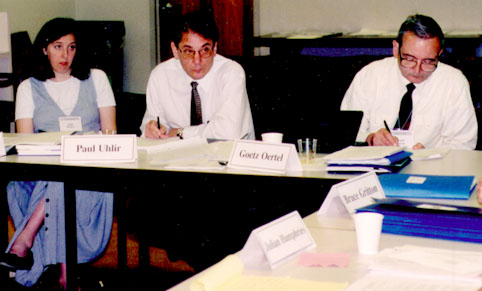
The "head table": J. Esanu (Program Associate), P. Uhlir
(Director), G. Oertel
![The USNC (counterclockwise): W. White, W. Bonner, M. Krichevsky, L. Blaine, J. Esanu, P. Uhlir, G. Oertel, B. Gritton, J. Humphries, E. Buck, M. Chinnery (ex officio) [(Not shown: N. Gershon, J. Rumble, E. Westrum (ex officio), W. Barker (ex officio), P. Gamble (Project Assistant)]](images-news/coda783.jpg)
The USNC (counterclockwise): W. White, W. Bonner, M. Krichevsky,
L. Blaine, J. Esanu, P. Uhlir, G. Oertel, B. Gritton, J. Humphries, E.
Buck, M. Chinnery (ex officio) [(Not shown: N. Gershon, J. Rumble, E. Westrum
(ex officio), W. Barker (ex officio), P. Gamble (Project Assistant)]
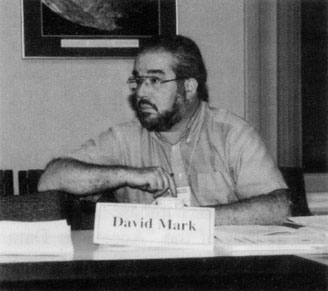
D. Mark
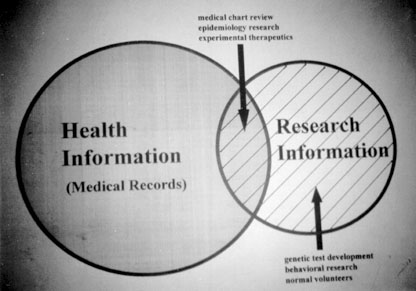
The Mini-Symposium Theme: Distinguishing Between Health and Research
Information
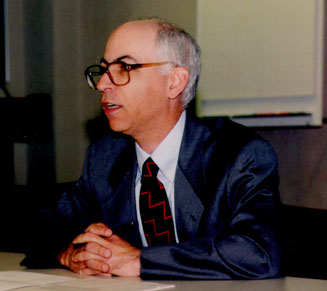
R. Gelmann, Consultant
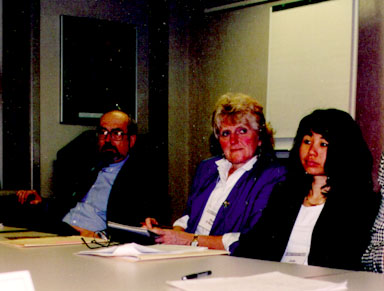
J. Fanning (Dept. Health and Human Services), P. O'Rourke, J. Kaneshiro
(Nat'l. Institutes of Health)
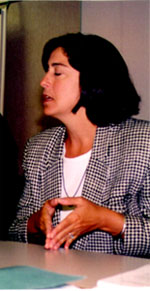
J. Goldman (Georgetown Univ. Medical Center)
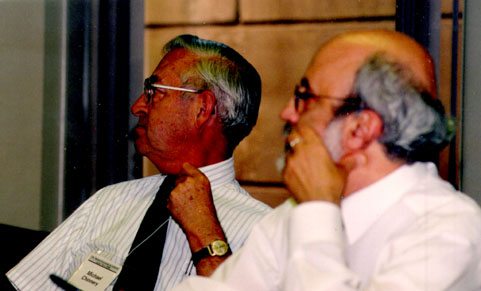
M. Chinnery (ex officio), M. Kafatos
Looking ahead to the future, many exciting and challenging data-related issues remain to be addressed, not only for materials, but also for all of science and technology. As we enter the 21st century, CODATA will continue to provide a global presence and venue for the advocacy of reliable scientific and technical data, including engineering materials. <Back
Information Visualization and Management of Heterogeneous Systems
On 7 November at New Delhi (i.e., two days prior to the Inaugural Session of the CODATA Conference) a study workshop has been scheduled with a registration fee of Rs. 2000 for Indian participants and $80 for other participants.
Increasing amounts of data and information and the availability of fast digital network access (e.g., the World Wide Web) have created a demand for querying, accessing, and retrieving either information or data.
The thrust of this study workshop demonstrates the current status of these important fields as well as future directions for research and development and for real-world implementation.
Information Visualization: This is an increasingly important research and development area and is crucial for the success of the information revolution. Information Visualization involves the conversion of the abstract into concrete visual representations and building user interfaces supporting tasks such as searching, discovery, identification, and data mining.
Management of Heterogeneous Data, Information, and Knowledge: Quite frequently, data and information systems are built independently yielding highly heterogeneous and distributed systems producing fragmented views of data and information. Users need systems that are able to share and exchange information on a global basis without knowledge of the detailed structure of each local data system nor the different access methods.
The first half day will be dedicated to information visualization including a short tutorial and a survey of the state-of-the-art developments. The survey of the current status involve talks by the following well known experts in the field of information visualization: Kenneth R. Boff (US Air Force Research Lab), Stuart K. Card (Xerox PARC), Stephen G. Eick (Bell Labs), and Nahum Gershon (The MITRE Corp.).
The second half day will consist of a tutorial presented by Hélène Bestougeff (University of Paris) on intelligent integration of heterogeneous data systems as well as concepts and tools for data exchanges through standardized models; and a presentation by Anne Francoise Cutting Decelle (University of Chambéry) to provide a global overview of the industrial environment, company needs in terms of industrial communication, and the possible answers provided by standardization of data models. Her talk will describe and comment on current work in "Industrial automation systems and integration" by a committee under the auspices of the ISO TC 184 standardization.
Proposals for reports on industrial and academic cases are solicited. The level of the tutorials will be beginner to intermediate. Participants will receive proceedings and tutorial notes.
The study workshop, to be supported by CODATA and industrial and commercial organizations, will be conducted in cooperation with IEEE Computer Society Task Force on Human Centered Information Systems.
For additional information note pages 14 to 16 in the preliminary scientific program. <Back
Organic Systems and Dynamic Classification Problems
in Geophysical Applications. J. O. Dubois and A. Gvishani. Data
and Knowledge in a Changing World Series.
Books and Databases
DIPPR®, The AIChE's Data Compilation of Pure Compound Properties.
DECHEMA Chemistry Data Series. Vol. XII, Part 3. Electrolyte Data Collection, Viscosity of Nonaqueous Solutions, I: Alcohol Solutions. J. Bartel, R. Neueder, R. Meier.
DECHEMA Chemistry Data Series. Vol. XII, Part 3a. Electrolyte Data Collection, Viscosity of Nonaqueous Solutions, II: Aprotic and Protic Non-Alcohol Solutions C1-C3. J. Bartel, R. Neueder, R. Meier.
Ion Properties. Yizhak Marcus.
Thermodynamic Properties of Individual Substances, Vol. 3, Part I and II. Edited by L. V. Gurvich, I. V. Beyts, C. B. Alcock, and V. S. Iorish. (order)
Volumetric Properties of Electrolyte Solutions, G. G. Aseyev and I. D. Zaytsev. (order)
Thermal Properties of Electrolyte Solutions, G. G. Aseyev. (order)
Binary Diffusion Coefficients of Liquid Vapors in Gases, A. N. Berezhnoi and A. V. Semenov. (order)
CODATA Key Values for Thermodynamics
As a convenience to scientists, CODATA has established a table of internationally agreed values for the thermodynamic properties of key chemical substances. These are based on J. D. Cox, D. D. Wagman, and V. A.Medvedev, CODATA Key Values for Thermodynamics, Hemisphere, New York, 1989. The values presented at 298.15 K include the enthalpy of formation (DH°m,f), the standard entropy (S°m), and standard enthalpy [H°m,298.15 K - H°0 K]. This table presents the current results of the project. Use of these recommended, internally consistent values is encouraged in the analysis of the thermodynamic measurements, data reduction, and preparation of other thermodynamic tables. The standard state pressure is 105 (1 bar). Substances are listed in alphabetical order of their chemical formulas when written in the most common form. This table is on the CODATA website. An updated report is expected in the near future.<Back
High-Mountain Remote Sensing Cartography (HMRSC)
The 4th HMRSC symposium (at Karlstad University) proceedings were published in 1997 by Dr. Gerhard Bax (Chair) with B&W figures, and in digital format with colored figures both on a CD-ROM and on the INTERNET. 30 researchers from 16 countries and 5 continents participated in scientific meetings and in field excursions in the North of Sweden (Kiruna area) and Norway (Trömsö area). Lecture themes were devoted to the study of high mountain ecosystems considered as one of the most vulnerable parts of the world. Tools for studying these ecosystems were discussed.
The next HMRSC symposium will be hosted August 23 to 31 1998 by Humboldt State University in Arcata, California, USA. The coordinator is Dr. Stephen F. Cunha, Department of Geography, Humboldt State University (contact email to: sc10@axe.humboldt.edu). <Back
--Dr. Claude Bardinet
Scientific and Statistical Database Management
The SSDBM 98's 10th International Conference was held on the Island of Capri, Italy, July 1-3, 1998. The program of about 34 presentations covered many aspects of database analysis, management and tools.
Further information is available on the SSDBM home page: http://www.iasi.rm.cnr.it.
It is hoped that a proceedings will be prepared.
<Back
KUDO Ted Selover has been honored by being named an AIChE (American Institute of Chemical Engineers) Fellow among their 58,000 members. A Technical Consultant and college tutor in Cleveland, Ohio, he established a physical property databank in Standard Oil Co. Ohio in the early 1970's. He became the first Technical Director of Design Institutes for Physical Property Data (DIPPR) in 1990 and is still active there. He was active on CODATA's Task Group on World Data Depository from '92 through '95 and has edited AIChE Symposiium Series and other related volumes.<Back
[PICTURE here of Ted Selover]
In addition to the main CODATA website [http://www.codata.org/codata], three Task Groups have also established websites:
Eleven Union Members maintain or initiate sites.
Five National Members also operate sites: Canada, Chinese Academy of Sciences (Beijing), France, Senegal, and United States of America.
The home page of the parent site provides access to the URLs.
The CODATA Parent Site in particular provides convenient access to, e.g., ICSU/CODATA Position Paper on access to databases (Sept. 1997),Fundamental Constants, etc. <Back
1998
November
6-7 CODATA Data Sources East Asia Oceanic Task Group Meeting. New Delhi, India
8-12 CODATA 16th International Conference. New Delhi, India
10-11 CODATA Task Group on Biological Macro-molecules. New Delhi, India
13-14 CODATA General Assembly. New Delhi, India
| Editor: Edgar F. Westrum, Jr.
Department of Chemistry University of Michigan Ann Arbor, MI 48109-1055 Telephone: (313) 764-7357 FAX: +1-313-747-4865 E-mail: westrum@umich.edu |
Associate Editor: Phyllis Glaeser
CODATA Secretariat 51 Blvd. de Montmorency 75016 Paris, France Telephone: 33 1 45250496 FAX: +33 1 42881466 E-mail: codata@paris7.jussieu.fr |
Published three times per year (March, July, November)
Assistance in dissemination is provided by National Committees
CODATA has four primary activities, all in support of its fundamental aim of fostering world wide cooperation in scientific and technical data:
ï Sponsorship of Biennial CODATA International Conferences on data (in New Delhi November 1998) which attract approximately 300 multidisciplinary data specialists from around the world.
ï Sponsorship of 10-12 Task Groups addressing specific data issues, e.g., developing consensus nomenclature and or consensus tables of evaluated data in specialized areas, and facilitating the adoption of new information technology to scientific data handling.
ï Provision of several specialist meetings of scientific data experts annual, e.g., Materials Data Workshops.
ï Publications on data handling, data compilation, surveys of data
activities, as well as conference proceedings.<Back
Footnotes
This volume is the first in a series of two volumes that will discuss techniques for the analysis of natural dynamic systems and their application to a variety of geophysical problems. The present volume lays out the theoretical foundations for these techniques. The second volume will apply these techniques in applications to fields such as seismology, geodynamics, geoelectricity, geomagnetism, aeromagnetism, astromagnetics, topography and bathymetry.
The book itself consists of two parts which describe complementary approaches
to the analysis of natural systems. The first, written by A. Gvishani,
deals with dynamic pattern recognition; it lays out the theory and formalized
algorithms that form the basis for the classification of vector objects
and the use of this classification in the study of dynamical systems with
particular emphasis on the prediction of system behavior in space and time,
the evaluation of their stabilities and reliabilities. The second, written
by J. O. Dubois, is concerned with various theoretical tools that may be
applied to the modeling of natural systems using large sets of geophysical
data. 260 pp, many plates, some in color. ISBN 3-540-64238-2, available
from Springer Verlag, New York, NY .<Back
Order from Begell House, Inc., 79 Madison Avenue,
New York, NY 10016, (Tel: +1-212-725-1999; Fax: +1-212-213-8368).